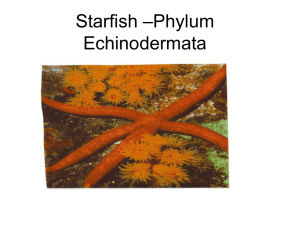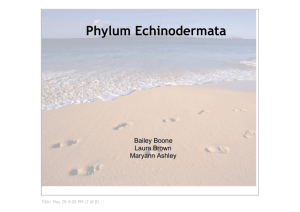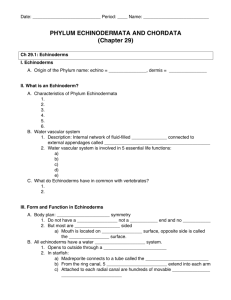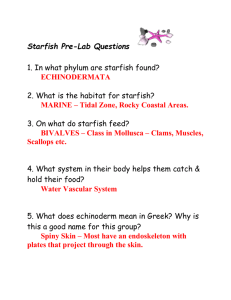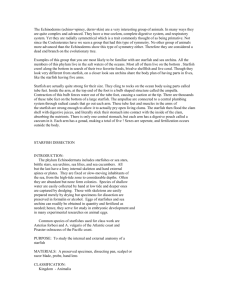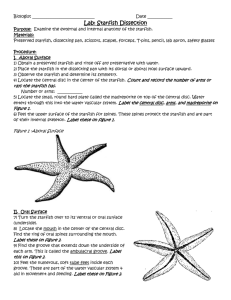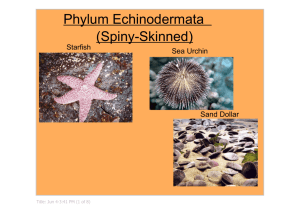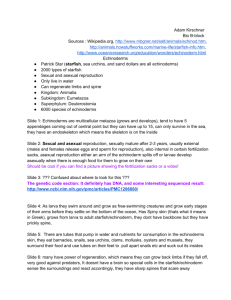Biology 11 - Starfish Dissection Guide
advertisement
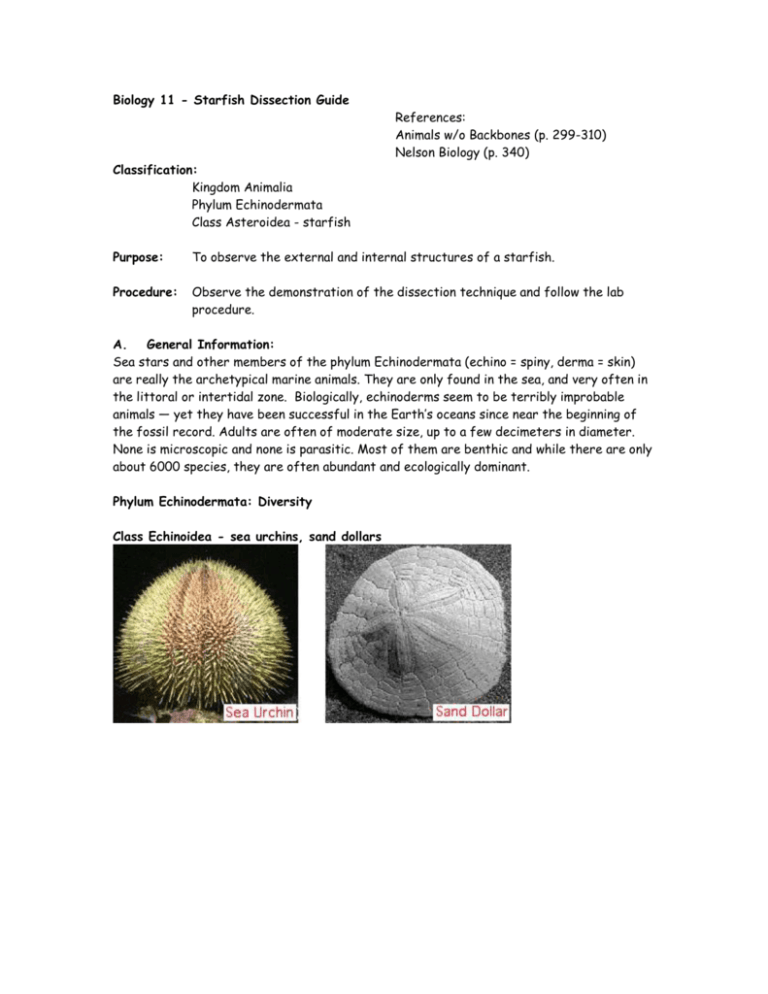
Biology 11 - Starfish Dissection Guide References: Animals w/o Backbones (p. 299-310) Nelson Biology (p. 340) Classification: Kingdom Animalia Phylum Echinodermata Class Asteroidea - starfish Purpose: To observe the external and internal structures of a starfish. Procedure: Observe the demonstration of the dissection technique and follow the lab procedure. A. General Information: Sea stars and other members of the phylum Echinodermata (echino = spiny, derma = skin) are really the archetypical marine animals. They are only found in the sea, and very often in the littoral or intertidal zone. Biologically, echinoderms seem to be terribly improbable animals — yet they have been successful in the Earth’s oceans since near the beginning of the fossil record. Adults are often of moderate size, up to a few decimeters in diameter. None is microscopic and none is parasitic. Most of them are benthic and while there are only about 6000 species, they are often abundant and ecologically dominant. Phylum Echinodermata: Diversity Class Echinoidea - sea urchins, sand dollars Class Ophiuroidea - brittle stars Class Crinoidea - sea lilies Class Asteroidea – starfish Class Holothuridea - sea cucumber B. External structures and body plan: The name of the phylum Echinodermata is derived from the Greek and means “spiny skin”. There are six classes, but probably the most familiar to most of us is the common starfish, Asteroidea. This genus is found along both coasts of North America where it crawls along the shallow sea bottom, feeding on mollusks. Many echinoderms exhibit radial symmetry, including the starfish. The body consists of a central disc, from which five arms extend (an unusual number of arms is possible, but most individuals have five). On the oral surface of the arms, an ambulacral groove is found, containing small, fingerlike tube feet, which are the organs of locomotion. At the base of the rows of tube feet may be seen a white nerve cord; at the tip of each arm is a light sensitive eye spot, that is extended upwards during locomotion. This image shows the aboral surface of a preserved starfish. Note the spiny skin, central disc and madreporite. The madreporite is part of the water vascular system. The image below shows the oral surface of a preserved starfish. Note the central mouth and ambulacral groove that runs down the center of the oral surface of each arm. Extending from each ambulacral groove are numerous tube feet that are used for locomotion, attaching to the substrate and feeding. The spines on the aboral surface are extensions of the skeletal plates. Surrounding each spine are skin gills, which function in respiration, and tiny structures called pedicellariae. The latter are composed of two jaws (moved by muscles) that open and shut, primarily to keep the body surface clean of debris. C. Internal Structures: Place your specimen in the dissecting pan so that the aboral surface is facing up. Read this whole section before proceeding with the dissection. Use scissors to make a hole just through the body wall at point A. Insert scissors into this hole and cut around the central disc (make cut as large as possible). Don’t cut too deeply. Use forceps to gently pull up and remove the top of the central disc that you have cut. Make sure you look for the very thin pyloric stomach which appears brownish and skin like and is attached to the underside of the central disc. Gently cut it loose. Choose a ray that is not bent or twisted. Start at points B and C. Cut along side to points D and E and than continue cutting down the arm and the remove skin. Identify all of the following structures. D. Skeleton: The starfish endoskeleton consists of a set of small calcium carbonate plates that lie buried below the skin of the starfish. The skeleton functions to both support and protect, which is obvious when examining specimens. With the exception of those comprising the spines of pencil urchins, all skeletal plates in echinoderms are covered with tissue. Unlike vertebrates and most other higher invertebrates, locomotion is not achieved by muscles attached to the skeleton elements. This skeleton is in some ways similar to that found in chordates, such as fishes, as is the general physiology of the animals, indicating a relatively close evolutionary relationship between these phyla. However, as a final bizarre note, no echinoderm has an old age or senescence. In effect, unless they starve to death, get diseased, get eaten or suffer from some environmental disaster, they have the potential of immortality. E. Locomotion: Starfish move around using a unique water vascular system. The internal canals of this system include a circular ring canal and its extensions into each arm, called radial canals. The stone canal links the ring canal to the outside through a hole on the aboral surface, called the madreporite. From both sides of the radial canals, short lateral canals arise; each contains a valve and terminates in a bulb called an ampulla and a tube foot - the foot ends in a small sucker. The water vascular system is filled with a fluid composed of seawater with added protein and potassium, and amoeboid cells. Its hydraulic actions provide the mechanism for locomotion. When the ampulla contracts, the valve closes and fluid is forced into the tube foot to elongate it. When the stretching foot makes contact with the surface below the animal, the center of the sucker surface retracts to produce a vacuum and cause the foot to adhere to the surface. After the foot sticks to the surface, muscular fibers shorten the foot again and force fluid back into the ampulla. Each tube foot is very small and moves the starfish only a small distance; however, the net movement from the many tube feet is able to provide a forward motion for the animal. F. Digestion The central disc contains the complete digestive tract, extending from a mouth on the oral surface (ventral) to the anus on the aboral surface (dorsal). In between, the digestive tract includes a short esophagus, a multilobed cardiac stomach, and an upper pyloric stomach. There is no “intestine”, but small rectal caecae are located near the anus to provide temporary storage of waste products. Food is digested in the stomach with the aid of enzymes produced in digestive glands, tissues occupying much of the space in each of the arms and draining their secretions into the stomach through pyloric ducts. G. Reproduction Sea stars are capable of both sexual and asexual reproduction. Individual sea stars are male or female. During the breeding season, the arms contain gonads that produce eggs or sperm, which are discharged from the body through gonopores in each arm. Fertilization is then external, and the larvae grow independently of the parents. The resulting fertilized embryos form part of the zooplankton. To increase their chances of fertilization, sea stars probably gather in groups when they are ready to spawn, use environmental signals to coordinate timing (day length to indicate the correct time of the year, dawn or dusk to indicate the correct time of day), and may use chemical signals to indicate their readiness to each other. Male and female sea stars look the same externally and internally (male and female gonads look alike). To determine the sex of the starfish, the gonads must be examined microscopically. To do this, remove a small piece of the reproductive organ and place it in a drop of water on a slide. Add a cover slip and examine under a microscope at high power. The testes of the male have flagellated sperm. The ovaries of the female produce spherical egg cells that are considerably larger than the sperm. Use a microscope to determine if you have a male or female starfish? H. Circulatory system The echinoderms may be considered to be constructed of cavities within cavities surrounded by cavities, all of which are lined with layers of fragile tissues. The cavity fluid is not seawater and is physiologically maintained by intracellular “molecular” pumps that regulate the animal’s ionic balance. This pumping system is delicate and depends to a great extent on the relative ionic balances between the animal’s internal environment and the surrounding ocean water. Under conditions of lowered salinity, most echinoderms lose the capability to regulate their necessary internal conditions and die. For the aquarist this means that full-strength salinity (between 35 and 37 ppt) is necessary for successful maintenance of most echinoderms. I. Nervous system The presence of radial symmetry implies no front end, and indeed, no head is found anywhere in the phylum. Probably as a consequence of the lack of a head, they are truly brainless, a characteristic shared with some other lower life forms. The remainder of the nervous system is poorly known as the nerves are exceptionally small and diffuse. Starfish Dissection Write up 1. On your chart, complete the example, phylum and general characteristics sections. 2. On your chart under external features, make an accurate drawing showing the oral and aboral surfaces. 3. On your chart under external features, describe the function of tube feet, madreporite and pedicellariae 4. On your chart under skeleton, describe the skeleton and the method of movement of the starfish. 5. On your chart under reproduction, describe external fertilization and why it is an adaptation for these organisms. 6. On your chart under digestion, describe how a starfish is adapted to eat a clam. 7. On your chart under circulatory system, describe how starfish control their internal environments and how starfish may die. 8. On your chart under respiration, describe the location of the skin gills. (See external features in dissection guide). 9. On your chart under nervous system, describe the nervous system of the starfish.

